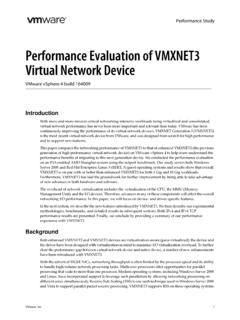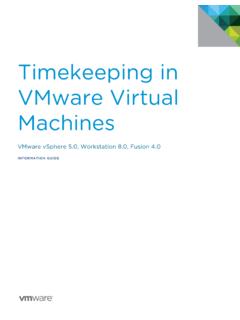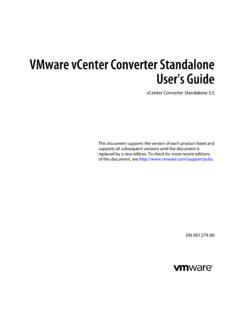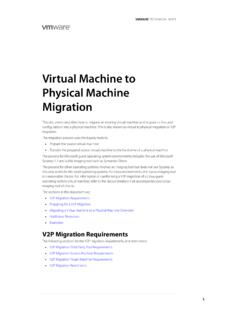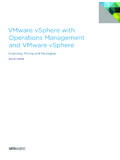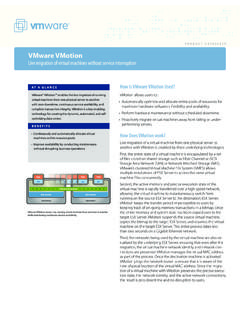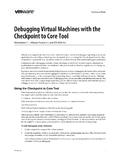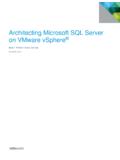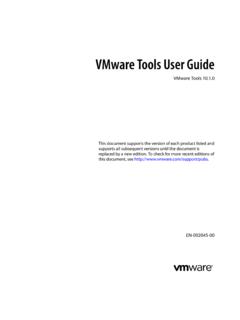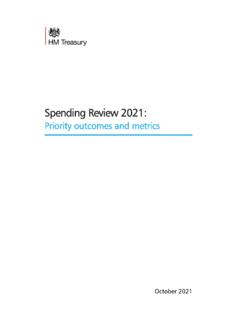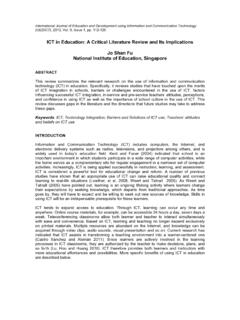Transcription of VMware vSphere Compute Virtualization
1 WH I T E P A P E R March 2021. VMware vSphere Compute Virtualization Licensing, pricing and packaging VMware vSphere Compute Virtualization Table of contents Executive summary 3. VMware vSphere overview 3. Licensing overview 3. vSphere 7 licensing: Per processor .. 3. License management .. 3. Decentralized licensing option .. 4. Example: Licensing new hosts with VMware vSphere Enterprise Plus 7 .. 4. Packaging overview 4. vSphere main editions .. 4. VMware vSphere Hypervisor .. 8. VMware vSphere Desktop .. 8. VMware vSphere Acceleration Kits .. 8. VMware vSphere Essentials Kits .. 8. VMware vSphere Remote Office Branch Office.
2 9. VMware vSphere 12. VMware Tanzu Basic .. 13. vCenter Server editions .. 14. VMware vSphere Platinum end of availability .. 14. Version upgrade entitlements for existing customers 15. Paid edition upgrades 15. WH I T E P A P E R | 2. VMware vSphere Compute Virtualization Executive summary This guide provides an overview of the licensing, pricing and packaging for VMware vSphereTM. The key topics discussed in this guide include: VMware vSphere overview Licensing overview Licensing metric and management Packaging overview Packaging options for editions (including VMware vCenter Server ), kits, vSphere Bitfusion and Tanzu Basic Version upgrade entitlements for existing customers Paid edition upgrades from vSphere 7.
3 vSphere Platinum end of availability VMware vSphere overview VMware vSphere is the leading server Virtualization platform with the best foundation for your applications, your cloud and your business. vSphere helps you get the best performance , availability and efficiency from your infrastructure and applications. It is the essential building block for modern cloud infrastructure. Licensing overview vSphere 7 licensing: Per processor vSphere 7 is licensed on a per-processor basis apply to select editions: vSphere Standard, vSphere Enterprise Plus, vSphere Acceleration Kits, vSphere Essential Kits, and vSphere Scale Out.
4 Each physical processor (CPU) in a server needs to have at least one processor license key assigned to be able to run vSphere . Each per-processor license will cover CPUs with up to 32 physical cores. If the CPU has more than 32 cores, additional CPU licenses are required. For more information, please refer to the VMware Product Guide or visit Update to VMware 's per-CPU Pricing Model ( ). No limit on the number of virtual machines There are no restrictions on the number of virtual machines (VMs) that can run on each properly licensed vSphere 7 processor. vSphere for virtual desktop deployments VMware vSphere Desktop is specifically designed for licensing vSphere when used to run virtual desktops.
5 It can only be used as a Virtualization platform for virtual desktop infrastructure (VDI) deployments with either VMware Horizon View or third-party connection brokers. For more details, see the Packaging overview section. License management vSphere 7 licenses are simple license keys (25-character alphanumeric strings) that contain encrypted information about the vSphere edition or kit purchased and the processor quantity. These license keys do not contain any server-specific information and are not tied to a specific piece of hardware. This means the same license key can be assigned to multiple vSphere hosts as long as the number of licenses required for physical processor units on those hosts does not exceed the encoded license quantity WH I T E P A P E R | 3.
6 VMware vSphere Compute Virtualization in the license key. To calculate the number of licenses required, consider each per- processor license includes licensing for up to 32 physical cores in each CPU. Centralized licensing with no single point of failure vCenter Server is the recommended interface for license assignment to vSphere hosts. When a license key is assigned by vCenter Server, it is copied to the host and saved in a persistent format. If the host becomes disconnected from vCenter Server, the license key remains active on the host indefinitely, even after a host reboot. Only a deliberate licensing operation by the user can remove or replace a host license key.
7 Decentralized licensing option VMware recommends that customers assign all vSphere licenses centrally through vCenter Server however, vSphere customers have the option to assign their license keys directly to individual hosts. There is no difference between directly and centrally assigned license keys. When a vSphere host is added to the vCenter Server inventory, any license key already on the host will become available for management, reporting and assignment in vCenter Server, just like any license key added directly via vCenter Server. For more information on licensing, visit the VMware Licensing Help Center.
8 ( ). Example: Licensing new hosts with VMware vSphere Enterprise Plus 7. 1. A user has two 2-CPU (each with up to 32 cores) hosts with 128GB of physical RAM. each that they wish to license with VMware vSphere Enterprise Plus Edition . Each physical CPU requires at least one license, so four vSphere Enterprise Plus 7 licenses are required. No additional licenses will be needed regardless of the number of VMs or the amount of virtual memory (vRAM). 2. A user has two 2-CPU (each with more than 32 cores and up to 64 cores) hosts with 128GB of physical RAM each that they wish to license with vSphere Enterprise Plus.
9 Each physical CPU requires two licenses because each CPU license covers up to 32. cores in a CPU, so eight vSphere Enterprise Plus 7 licenses are required. No additional licenses will be needed regardless of the number of VMs or the amount of vRAM. Packaging overview VMware offers several packaging options designed to meet customers' specific requirements for scalability, size of environment and use cases. vSphere main editions Customers can choose from two editions: VMware vSphere Standard Edition and vSphere Enterprise Plus (see Table 1). A support and subscription (SnS) contract is required for every edition purchased.
10 vSphere Standard provides an entry-level solution for basic server consolidation to slash hardware costs while accelerating application deployment. vSphere Enterprise Plus offers the full range of vSphere features for transforming data centers into dramatically simplified cloud infrastructures , and for running modern applications with the next generation of flexible, reliable IT services. For information on local currency prices for vSphere editions, visit the vSphere product page ( #pricing). WH I T E P A P E R | 4. VMware vSphere Compute Virtualization vSphere . vSphere ENTERPRISE. FEATURES STANDARD PLUS.
